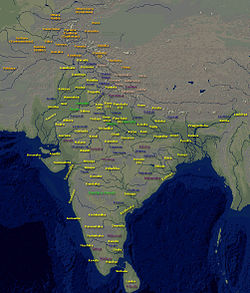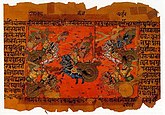Abhira kingdom
Abhira kingdom | |
|---|---|
 | |
| Religion | Bhagavata |
| Government | Monarchy |
| Historical era | Early Mahajanapada (Mahabharata) |
| Today part of | Pakistan India |
The Abhira kingdom in the Mahabharata is either of two kingdoms near the Sarasvati river. It was dominated by the Abhiras, sometimes referred to as Surabhira[1][2][3] also, combining both Sura and Abhira kingdoms. Modern day Abhira territory lies within Northern areas of Gujarat and Southern Rajasthan, India.[4]
Mahabharata
[edit]The Sabha-parva and Bhisma-parva sections of the Mahabharata mention the province of Abhira, situated near what once was the Sarasvati River in ancient Sind.[5] The Kshatriyas who were afraid of Parashurama and had hidden themselves in the Caucasian hilly regions later on became known as the Abhiras, and the place they inhabited was known as Abhiradesa.[6][7] Later, for a period of time, they were ruled by Maharaja Yudhisthira. they are prophesied by the sage Markandeya to rule in the Kaliyuga. Vātsyāyana also mentions the Abhira kingdoms in the Kama Sutra.[8] References of Abhira being residents of kingdom ruled by Yudhisthira is found in Bhagwatam.[9]
Abhiras are mentioned as warriors in support of Duryodhana in Mahabharta war.[10] The Gopas, whom Krishna had offered to Duryodhana to fight in his support when he himself joined Arjuna's side, were no other than the Yadavas themselves, who were also the Abhiras.[11][12] Their king Chitra, was killed by Prativindhya, the son of Yudhishthira and Draupadi.[citation needed] The Abhiras also have been described as Vratya Kshatriyas.[13] The Abhir, Gopa, Gopal.[14] and Yadavas are all synonyms.[15][16][17] They defeated the hero of Mahabharatha war, sparing him when he disclosed the identity of the members of the family of Sri Krishna.[18] Arjuna had killed all Kauravas and was defeated by Gopas (Abhiras) was only Hari's play.[19][20]
Abhira kingdom of Mathura
[edit]In the south was Mathura, the powerful kingdom of the fearless cow-herding Abhira tribe ruled by King Ugrasena, the maternal grandfather of Krishna.[21]
Abhira kingdom of Maharashtra
[edit]The Abhiras established a large kingdom in Maharashtra, succeeding the Satavahanas, which included Nasik, Aparanta, Lata, Khandesh and Vidarbha.[22][23][24]
Abhira kingdom of Saurashtra
[edit]The Abhiras began to rule in Southern and western Saurashtra from the second half of the 10th century A.D. Their capital was Vamanshtali, modern Vanthali nine miles west of Junagadh. They became very powerful during the reign of Graharipu who defeated the Saindhavas and the Chaulukyas.[25][26]
See also
[edit]- Abiria
- Abhira dynasty
- Abhira people
- Kingdoms of Ancient India
- Abhiras of Bhambhagiri
- Ahir
- Ahir clans
References
[edit]- ^ Garg, Gaṅgā Rām (1992). Encyclopaedia of the Hindu World. Concept Publishing Company. p. 113. ISBN 978-81-7022-374-0.
- ^ The Vishnu Purana a System of Hindu Mythology and Tradition Translated from the Original Sanskrit, and Illustrated by Notes Derived Chiefly from Other Puranas by the Late H.H. Wilson: 2. Trubner. 1865. p. 133.
- ^ Atkinson, Edwin T. (1 January 1874). Statistical, descriptive and historical account of the North-western Provinces of India. Dalcassian Publishing Company. p. 360.
The Suras and Abhiras' are associated together in the Mahābhārata and Harivansa and appear to have been a pastoral people in the upper portion of the north-western Panjāb represented by the Ahirs and Gwalas of the present day.
- ^ Numismatic Society of India (1991). The Journal of the Numismatic Society of India. Vol. 53. ISSN 0029-6066.
- ^ Knapp, Stephen (2000). Proof of Vedic Culture's Global Existence. World Relief Network. p. 55. ISBN 978-0-9617410-6-8.
- ^ Prabhupāda, A. C. Bhaktivedanta Swami (1987). Śrīmad Bhāgavatam: With the Original Sanskrit Text, Its Roman Transliteration, Synonyms, Translation and Elaborate Purports. Bhaktivedanta Book Trust. p. 215. ISBN 978-0-89213-251-5.
The kṣatriyas who were afraid of Parasurama and had hidden themselves in the Caucasian hilly regions later on became known as the Abhiras, and the place they inhabited was known as Abhiradeśa.
- ^ Naravane, Vishwanath S. (1987). A Companion to Indian Mythology: Hindu, Buddhist & Jaina. Thinker's Library, Technical Publishing House. p. 2.
Abhira (s), A clan of people who were originally Ksha-triyas but were later regarded as degraded because they took to lowly pursuits after settling down in mountainous regions. They migrated to far-off regions because they were afraid of Parashurā-ma, who had vowed to destroy the kshatriyas.
- ^ Sircar, Dineschandra (1971). Studies in the Geography of Ancient and Medieval India. Motilal Banarsidass Publ. p. 98. ISBN 978-81-208-0690-0.
- ^ "Srimad Bhagavatam Canto 2 Chapter 4 Verse 18". vedabase.net. Archived from the original on 19 August 2006. Retrieved 20 November 2021.
- ^ Man in India – Google Books. 17 July 2007. Retrieved 18 October 2011.
- ^ Man in India – Google Books. 1974. Retrieved 18 October 2011.
- ^ Shah, Popatlal Govindlal (13 February 2009). Ethnic history of Gujarat – Popatlal Govindlal Shah – Google Books. Retrieved 18 October 2011.
- ^ Thapar, Romila (1978). Ancient Indian Social History: Some Interpretations. Orient Blackswan. p. 149. ISBN 978-81-250-0808-8.
- ^ Regmi, D. R. (1 December 1973). Ancient Nepal – D. R. Regmi, Nepal Institute of Asian Studies – Google Books. Retrieved 18 October 2011.
- ^ Kapoor, Subodh (2002). Encyclopaedia of ancient Indian ... – Subodh Kapoor – Google Books. Cosmo Publications. ISBN 9788177552980. Retrieved 18 October 2011.
- ^ Rao, M. S. A. (14 December 2006). Social movements and social ... – M. S. A. Rao – Google Books. Macmillan. ISBN 9780333902554. Retrieved 18 October 2011.
- ^ Rao, M. S. A. (14 December 2006). Social movements and social ... – M. S. A. Rao – Google Books. Macmillan. ISBN 9780333902554. Retrieved 18 October 2011.
- ^ Singh Yadav, J. N. (28 August 2007). Yadavas through the ages, from ... – J. N. Singh Yadav – Google Books. Sharada Publishing House. ISBN 9788185616032. Retrieved 18 October 2011.
- ^ Söhnen, Renate; Söhnen-Thieme, Renate; Schreiner, Peter (1989). Brahmapurāṇa: Summary of Contents, with Index of Names and Motifs. Otto Harrassowitz Verlag. ISBN 978-3-447-02960-5.
Arjuna had killed all Kauravas and was defeated by Abhiras was only Hari's play.
- ^ Books, Kausiki (24 October 2021). Vishnu Purana Part 2: संक्षिप्त विष्णु पुराण: केवल हिन्दी (in Hindi). Kausiki Books.
आज उन्हीं कृष्ण के बिना, मुझे गोपों ने हरा दिया। जिनके प्रभाव से यह गाण्डीव तीनों लोकों में विख्यात था, आज उन्हीं के अभाव में यह अहीरों की लाठियों से व्यर्थ हो गया।
- ^ Geraets, Wil (18 May 2011). The Wisdom Teachings of Harish Johari on the Mahabharata. Simon and Schuster. ISBN 978-1-59477-932-9.
In the south was Mathura, the powerful kingdom of the fearless cow-herding Abhira tribe ruled by King Ugrasena, the maternal grandfather of Krishna.
- ^ Sudhakar Chattopadhyaya (1974). Some Early Dynasties of South India. Motilal. p. 129. ISBN 9788120829411.
{{cite book}}:|work=ignored (help) - ^ Subodh Kapoor (2002). Encyclopaedia of Ancient Indian Geography, Volume 1. Cosmo Publications. p. 2. ISBN 9788177552980.
{{cite book}}:|work=ignored (help) - ^ Central Provinces District Gazetteers- Nagpur.
- ^ Sailendra Nath Sen (1 January 1999). Ancient Indian History and Civilization. New Age International. p. 344. ISBN 978-81-224-1198-0. Retrieved 3 January 2011.
The Abhiras began to rule in Southern and western Sourashtra from the second half of the 10th century A.D their capital was vamanshtali, modern vanthali nine miles west of Junagadh. They became very powerful during the reign of Graharipu who defeated the Saindhavas and the Chaulukyas.
- ^ Majumdar, Ramesh Chandra (1964). Ancient India. Motilal Banarsidass. p. 303.
The Abhiras grew very powerful during the reign of Graharipu in the middle of the 10th century A.D. He had his capital at Vāmanasthali, now represented by Abhiras the village Vanthali, 9 miles west of Junagadh.
- Kisari Mohan Ganguli, The Mahabharata of Krishna-Dwaipayana Vyasa Translated into English Prose, 1883–1896.

